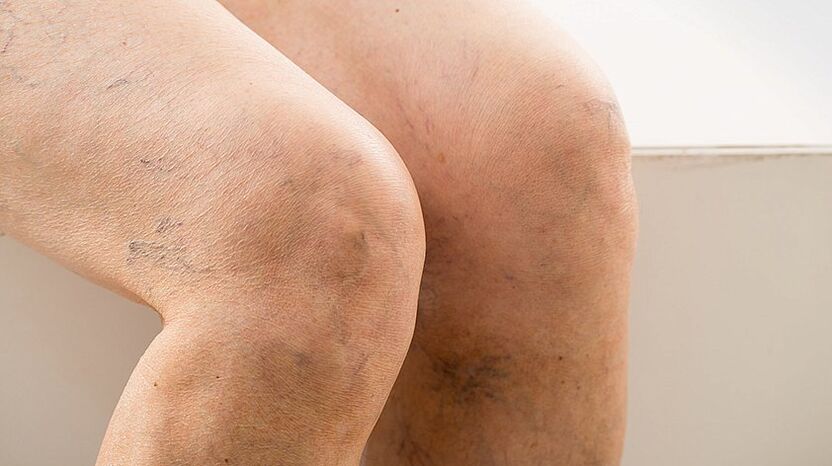
Varicose veins most often affect the venous system of the legs. External manifestations (prominent, swollen, nodular blue veins) are not just a cosmetic problem, but signs of a serious disease that worsens over time.
What are varicose veins: definition of the disease
The word "varicose veins" comes from the Latin varix - "swelling". The name fully reflects the pathological process: the walls of the veins become thinner, and expansions (swelling like sacs) - nodes - are formed in some areas.
The first case of varicose veins is recorded in documents from 86 BC. BC: Roman general Gaius Marius complained of pain in his leg due to "blue swollen veins. "
The main reason for the development of varicose veins (varicose veins, varicose veins) is increased pressure in the superficial vascular system. This is facilitated by certain diseases, hormonal changes and a sedentary lifestyle.
At first, even under the influence of these factors, the vessels function normally, but gradually they become deformed, change their structure and can no longer fully transport blood.
Varicose veins can develop on almost any part of the body, but most often appear on the lower legs. Therefore, when it comes to varicose veins, by default they mean leg problems.
Code for varicose veins in ICD-10
The International Statistical Classification of Diseases and Related Health Problems, Tenth Revision (ICD-10) includes several types of varicose veins.
I83 - varicose veins of the lower leg:
- I83. 0 - varicose veins on the lower leg with ulcers;
- I83. 1 - varicose veins on the lower leg with inflammation;
- I83. 2 - varicose veins on the lower leg with ulcers and inflammation.
85 - esophageal varicose veins:
- I85. 0 - esophageal varices with bleeding;
- I85. 9 - esophageal varices without bleeding.
I86 - varicose veins of other localization:
- I86. 0 - varicose veins from sublingual veins;
- I86. 1 - scrotal varicose veins (anatomical formation in men - container for testicles and their appendages);
- I86. 2 - pelvic varicose veins;
- I86. 3 - varicose veins of the vulva (female external genitalia);
- I86. 4 - abdominal varicose veins.
O22. 0 - varicose veins on the lower legs during pregnancy.
In our country, 30 million people suffer from various forms of varicose veins. A third of them have complications - trophic ulcers. An open defect in the skin or mucous membrane that occurs due to impaired blood circulation and tissue preservation.
Mechanisms of varicose vein development
The pathological reaction of the body is the same for all types of varicose veins, regardless of the cause of the problem. Understanding the anatomical features of blood vessels will help understand how and why the disease develops.
How blood moves through the body
There are two types of vessels in the human body - veins and arteries. Blood flows through arteries from the heart to all organs and tissues. This occurs under high pressure (70–120 mm Hg) and at high speed.
Blood flows through veins from organs and tissues, it is directed to the heart under low pressure (0-20 mm Hg).
The walls of veins are less thick and elastic than the walls of arteries, and, unlike arteries, do not contain such a well-developed layer of muscle. Therefore, varicose veins may only be in veins, but not in arteries.
Human circulatory system arteries and veins. Veins are shown in blue, arteries in red.
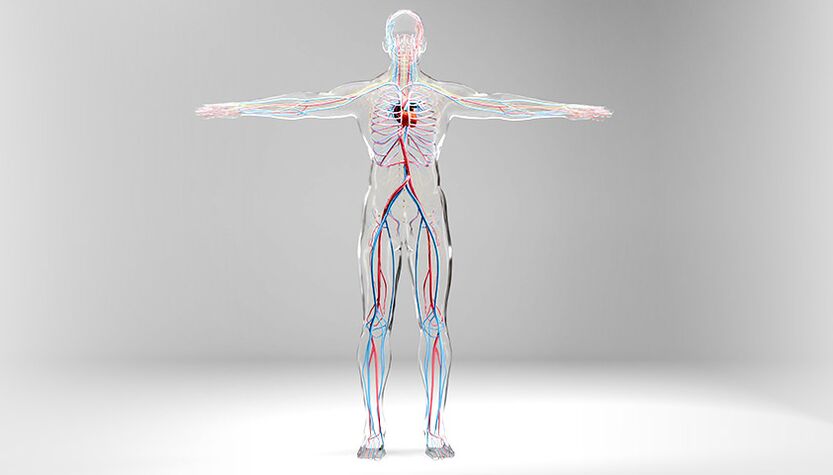
Low pressure in veins is needed to transport blood from the periphery to the center. But at the same time, on the way to the heart, the blood flow encounters an obstacle - the force of gravity. This force forces the blood back through the veins.
You often hear that varicose veins are the human response to walking upright. After all, the longest distance blood must travel in the body, overcoming gravity, is the path from the legs to the heart. The movement of blood through the veins is ensured by the contraction of the heart, the muscular pump of the surrounding muscles, and the negative pressure in the chest during inhalation.
In a healthy vein, the backflow of blood is prevented by a valve on the inner wall of the vein. The valve acts like a one-way swing gate - it opens and allows blood to flow into the heart and immediately closes if gravity tries to push the blood back out.
It is not only the valves that help the veins send blood to the heart, but also the muscles that surround the vessels. By contracting and relaxing, muscles help move blood through the veins. This mechanism only works when a person moves. When standing or sitting for a long time, the muscle pump can be said to be inactive.
The apex of the venous valve always faces the direction of blood flow - towards the heart
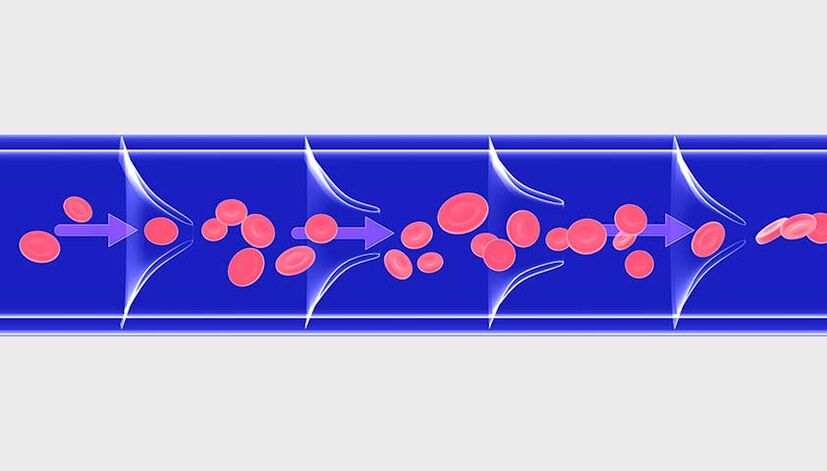
How failure occurs and disease occurs
Increased pressure in the vein system interferes with the function of their valves and leads to backflow of blood through the vessels. Because of this, as well as due to excessive blood stagnation, weakness of the valve apparatus (for example, in connective tissue diseases), the lumen of the vein expands, the wall becomes deformed, becomes thinner and resembles a local bag. protrusions - nodes - are formed.
The process is similar to blowing up a balloon: if you don't let the air out, the balloon expands more.
On the left is normal blood flow; on the right - multidirectional blood flow due to dysfunction of venous valves, vascular deformation
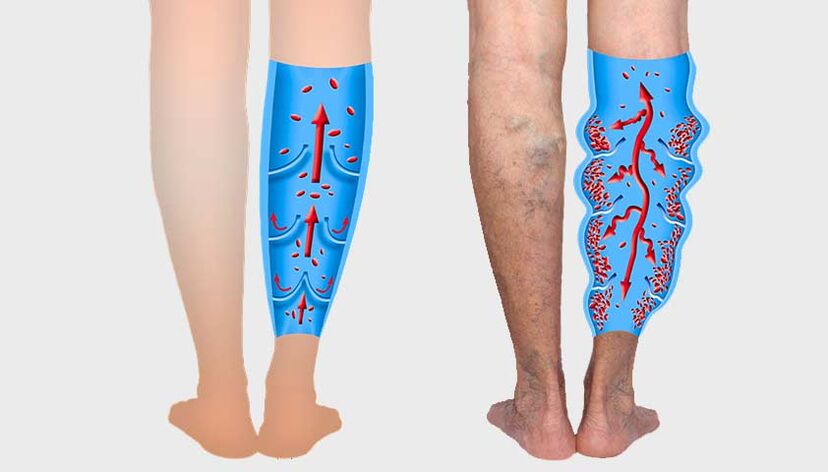
There are superficial and deep veins in the legs. 85-90% of the total blood volume passes through the deep, only 10-15% through the superficial. The walls of the deep veins are denser and more adapted to the increased blood volume. And the superficial veins of the legs are thinner and more susceptible to varicose veins.
In the pelvis and the lower part of the esophagus there is a large venous plexus, which can also undergo varicose transformation. In the small pelvic vein, the mechanism of disease progression is the same as in the lower leg. But esophageal varicose veins arise for other reasons: due to portal hypertension - increased pressure in the portal venous system, which develops with cirrhosis of the liver, hepatitis, parasitic liver lesions, fatty hepatosis, etc.
Causes of varicose veins
Several factors contribute to the development of varicose veins in the legs. The main thing isvalve insufficiencyAnddescent. It is known that a quarter of patients have close relatives who suffer from one form of varicose veins.
Excess body weight. The more extra pounds a person has, the greater the load on the venous system. Over time, the vein no longer faces such pressure: the lumen of the vessel increases, and the valve in its wall stops closing completely. As a result, blood stagnates and varicose veins develop.
Pregnancy. Hormonal changes occur in the female body, weight, intra-abdominal pressure and the amount of circulating blood increase - this leads to outflow disturbances, causing stretching of the vein walls and changes in the function of the valve apparatus.
After childbirth, the diameter of the dilated veins decreases, but does not always return to its original value. With subsequent pregnancies, the risk of developing varicose veins increases.
Age. Varicose veins often attack people after the age of 50. The older a person is, the more the venous valve wears out, while the recovery process slows down and the pathological expansion mechanism of veins is triggered - the development of varicose veins.
Venous refluxVenous reflux The return of blood through the veins due to resistance to blood flow, from lat. refluo - "flowing backwards. "found in 10–15% of schoolchildren aged 12–13 years. This disease "gets younger" due to an inactive lifestyle and excess weight.
Varicose veins on the lower legs develop faster if there are additional risk factors.
Risk factors that contribute to the development of varicose veins in the legs:
- lack of physical activity - when moving, muscles stimulate blood flow through the veins, and without movement, blood circulation in the veins can be difficult;
- smoking - chemicals contained in tobacco smoke damage the walls of blood vessels, as a result of which their lumen narrows, blood flow becomes difficult and stagnation occurs, which leads to varicose veins;
- professions that involve standing or sitting for long periods of time - hairdressers, surgeons, cooks, waiters, drivers, office workers are at risk;
- menopause - in women aged 40-50, the production of sex hormones (estrogen and progesterone) decreases, and at the same time the tone of the vein walls decreases. This increases the likelihood of varicose veins.
Women suffer from varicose veins 3-4 times more often than men. This happens because of hormonal variability (menstrual cycle, pregnancy, menopause).
During pregnancy, varicose veins can affect different parts of the body: legs, thighs, vulva

Varicose veins can occur not only in the lower legs, but also in other parts of the body.
The main cause of varicose veins in various locations
Esophageal varicose veins
Changes in the esophageal veins with an uneven increase in their lumen, wall protrusion and the development of nodular tortuosity of the vessels. Often leads to life-threatening complications - bleeding.
Reason:
- cirrhosis
- liver cancer
- another disease that causes increased pressure in the portal venous system - it collects blood from the abdominal organs
Varicose veins of the scrotum (varicocele)Pathological dilatation of testicular pampiniform plexus veins. Manifested by varicose veins in the scrotum and impaired blood flow
Reason:
- congenital incompetence of the testicular venous valve (usually the left one)
- mechanical compression of the testicular vein (inguinal hernia)
Pelvic varicose veins
It is characterized by dilation of ovarian veins and intrapelvic venous plexus of various diameters. This condition is also known as pelvic congestion syndrome
Reason:
- polycystic ovary syndrome
- two or more pregnancies
- hormonal dysfunction
Vulvar varicose veins
Pelvic varicose veins, which affect the labial and perineal ducts
Reason:
- compression of the retroperitoneal tract by the uterus during pregnancy
- significant physical activity
- uterine and ovarian tumors
Varicose veins in the sublingual vein (sublingual knotted vein)
Asymptomatic damage to the veins located under the tongue. Manifests itself as a slight protrusion of blood vessels and a change in color from dark blue to purple
Reason:
- hypertension
- smoking
- old age
Abdominal varicose veins
Isolated changes in the stomach veins or combined with esophageal varicose veins
Reason:
- cirrhosis
- portal hypertension syndrome - increased pressure in the portal venous system in other gastrointestinal diseases (neoplastic tumors, thrombosis, abnormalities of venous development)
Symptoms of varicose veins
In rare cases, only the aesthetic part of the disease appears - bluish veins. Most patients with varicose veins in the legs report at least one or more unpleasant symptoms.
Symptoms of varicose veins on the lower legs:
- fatigue, pain or a feeling of heaviness in the legs - this is caused by the stagnation of blood and its pressure on the surrounding tissues;
- burning, tingling or throbbing in the legs - a reaction to the slow blood flow and overflow of the venous system in the lower part of the legs;
- nocturnal muscle cramps in the legs - painful cramps occur due to blood stagnation and the accumulation of metabolic products in the tissues;
- swelling of the legs and ankles - due to stagnation in the veins, the liquid part of the blood seeps into the subcutaneous tissue through the altered vascular walls;
- itching of the skin around damaged veins - dilated and altered blood vessels do not provide normal blood circulation and nutrition to the skin, so it becomes dry and rough.
Unpleasant sensations in the legs in patients with varicose veins increase in the evening, especially after sitting or standing for a long time.
The appearance of altered veins is not always proportional to the severity of symptoms. Therefore, veins that are barely visible to the eye and affected by varicose veins can cause severe discomfort, while nodular and thickened veins can cause minimal concern.
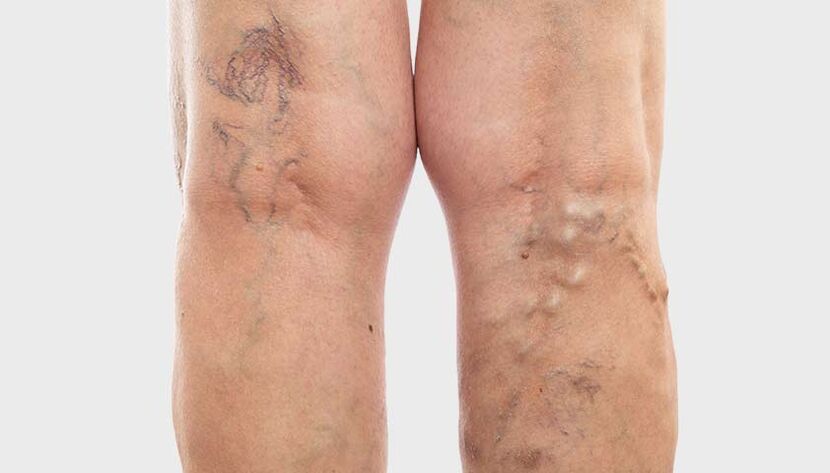
Varicose veins affect different veins: from small vessels of the skin to the large saphenous vein
Symptoms of other types of varicose veins largely depend on the cause of the disease. Often the patient does not complain about anything, and the doctor identifies the problem only during the examination. This happens, for example, with varicose veins from sublingual veins.
In some cases, such as esophageal or stomach varicose veins, the pathology immediately manifests itself as a life-threatening complication - bleeding.
Classification of vein diseases
In clinical practice, doctors rely on the international classification of venous diseases - CEAP. This is an abbreviation formed by the initial letter of the main part of the classification:
- C - clinic (clinical changes);
- E - etiology (origin of the disease);
- A - anatomy (anatomical localization of varicose veins);
- P - pathogenesis (mechanism of venous blood flow disorders).
Complications of varicose veins in the legs
Usually, varicose veins in and of themselves are not life-threatening. But sometimes the disease can cause complications.
Thrombophlebitis- inflammation of the vein wall, which is accompanied by the formation of a thrombus (blood clot) closing the lumen of the vessel. It manifests itself as swelling and redness along the affected veins. The patient experiences pain, the skin in the affected area becomes red and hot to the touch.
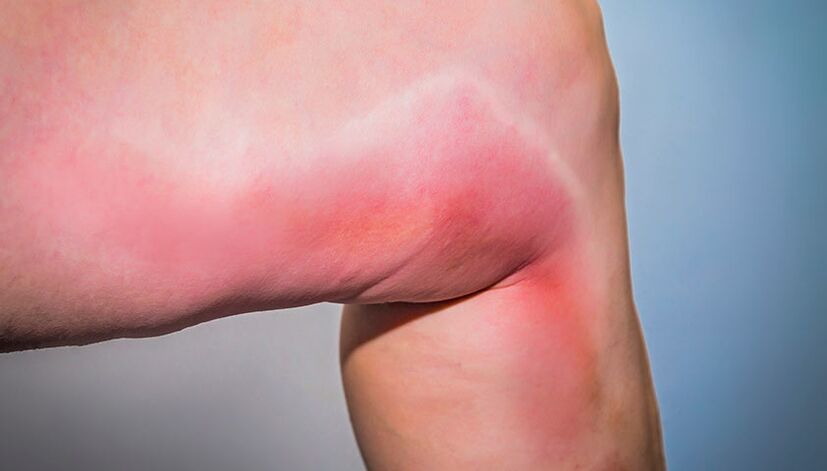
Thrombophlebitis is an inflammatory reaction of the skin and subcutaneous tissue along a thrombosed vein.
Venous trophic ulcers- open defects in the skin and soft tissues due to blood stagnation, edema and impaired cell nutrition. Ulcers occur on the legs and ankles near the varicose vein area. In the lower part of the leg, the swelling is more pronounced, which means that the tissue is compressed more than in other areas. Ulcers take a long time to heal, and they often contain bacteria, which increases inflammation.
Trophic ulcers heal poorly because blood circulation and tissue nutrition are impaired
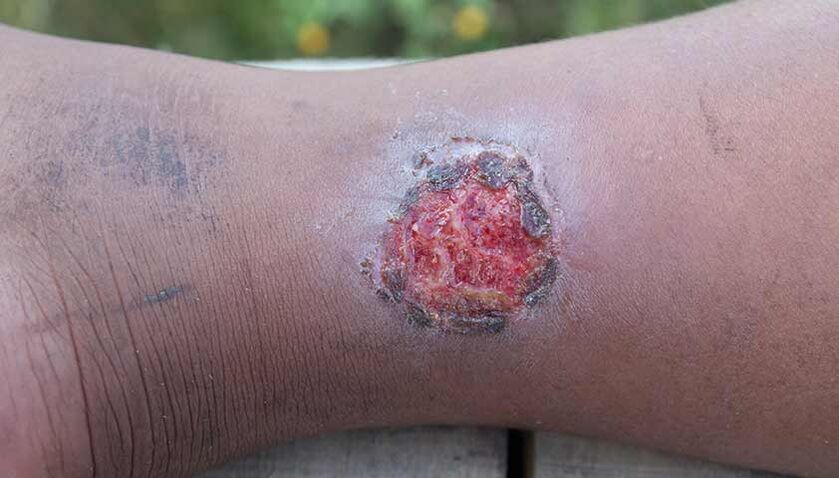
Bleeding- occurs when the vein breaks, enlarges due to varicose veins. In the final stages of the disease, the skin over such veins is very thin and dry - a small injury is enough for the integrity of the vessel to be compromised and bleeding to occur. Sometimes spontaneous rupture of veins occurs in the area of varicose nodes.
Diagnosis of varicose veins in the legs
Phlebologists deal with the diagnosis, treatment and prevention of venous diseases. The doctor makes a diagnosis based on the patient's complaints, examination and instrumental studies. If the symptoms of varicose veins are expressed, tests are usually not prescribed: a doctor's examination is enough.
The doctor may prescribe laboratory tests in preparation for surgery or to exclude concomitant diseases that affect the condition of the blood vessels.
One of these diseases is diabetes mellitus. It can worsen the course of varicose veins and increase the risk of complications (especially trophic ulcers).
For accurate diagnosis and determination of treatment tactics, you need duplex ultrasound scanning - the gold standard for diagnosing vascular conditions. This method allows you to evaluate the structure, function, patency of superficial and deep veins, valve consistency, and also determine the direction of blood flow.
If the secondary nature of varicose veins is suspected (may occur after deep vein thrombosis), the doctor prescribes venography, CT or MRI venography.
Phlebography is an X-ray examination used to determine deep vein patency and valve function.
Computer or magnetic resonance venography is used to visualize the venous system in a three-dimensional projection and at a very high spatial resolution.
Treatment of varicose veins in the legs
The goal of treating varicose veins is to reduce or eliminate symptoms, improve the appearance of the veins, and prevent complications.
Doctors choose treatment methods depending on which vessels are affected and how serious the condition of the patient with varicose veins is.
Non-invasive treatment
Non-invasive treatments for varicose veins include compression therapy, drug therapy, and lifestyle changes.
Compression therapy involves wearing special socks, stockings and tights. The choice of model, type of fabric and level of compression depends on the symptoms. The doctor will help you choose the right knitwear.
A compression jersey on the bottom of the leg compresses more than on the top of the leg - thereby pushing blood towards the heart and eliminating stagnation
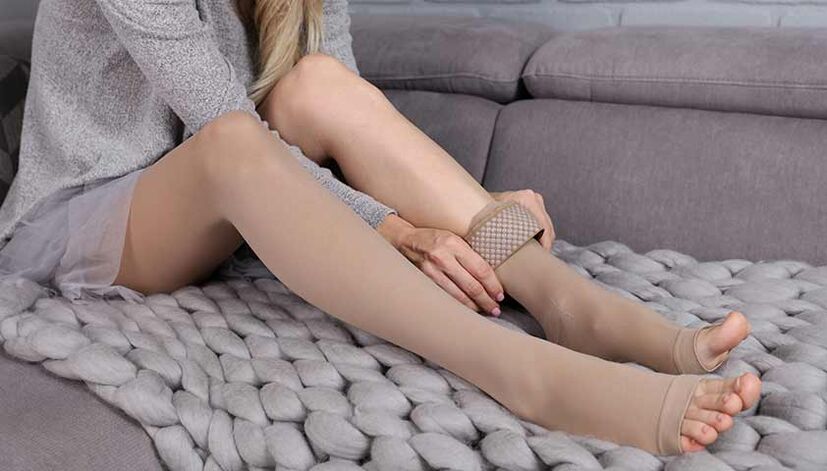
Effects of compression therapy for varicose veins:
- the manifestation of symptoms decreases - heaviness, fatigue in the legs, night cramps, burning sensation or pain;
- the severity of edema decreases due to better blood circulation;
- The healing of trophic ulcers is accelerated, because elastic compression improves blood circulation and tissue nutrition.
Drug therapy - doctors can prescribe Phlebotropic phlebotropic drugs (phleboprotectors, venotonics) Biologically active substances that increase venous tone and reduce the severity of venospecific symptoms. medicine (venotropic).
The main group of phlebotropic drugs used for varicose veins:
- angioprotectors: improve microcirculation, normalize increased capillary permeability, reduce blood viscosity and the possibility of blood clotting;
- antithrombotic agents: reduce the risk of the formation of dangerous blood clots (thrombi) in the lumen of blood vessels and promote the dissolution of existing ones;
- bioflavonoids: natural plant compounds that improve venous tone and reduce venous congestion.
Lifestyle changes for varicose veins significantly slow down the progression of the disease, and in combination with other recommendations of the attending physician, it helps stop the pathological process.
Important instructions in changing the lifestyle of patients with varicose veins:
- moderate intensity exercise: walking, swimming, water aerobics, leg exercises, yoga. Strengthening the muscles will help normalize blood circulation in the vessels, relieve venous stagnation and edema;
- weight control: thanks to the normalization of body weight, the load on the blood vessels is reduced and the return of blood through the veins to the heart is facilitated;
- abandon bad habits: nicotine and alcohol damage the inner walls of blood vessels and disrupt the regulation of vascular tone. Quitting smoking and drinking alcohol improves the condition of veins and valve function.
Invasive methods to treat varicose veins
Invasive treatments include medical procedures that affect the integrity of the skin or mucous membranes. Sclerotherapy is a procedure using a special sclerosing solution (sclerosant). The solution is injected into the problematic vein through a thin needle, which causes its sclerosis - "sticking". Veins are cut off from the blood flow and become invisible over time as their function is taken over by neighboring veins. Sclerotherapy is carried out without hospitalization - after the procedure the patient can go home.
The sclerotherapy procedure takes from 5 to 30 minutes, depending on how many varicose veins need to be filled with sclerosant and how big they are.
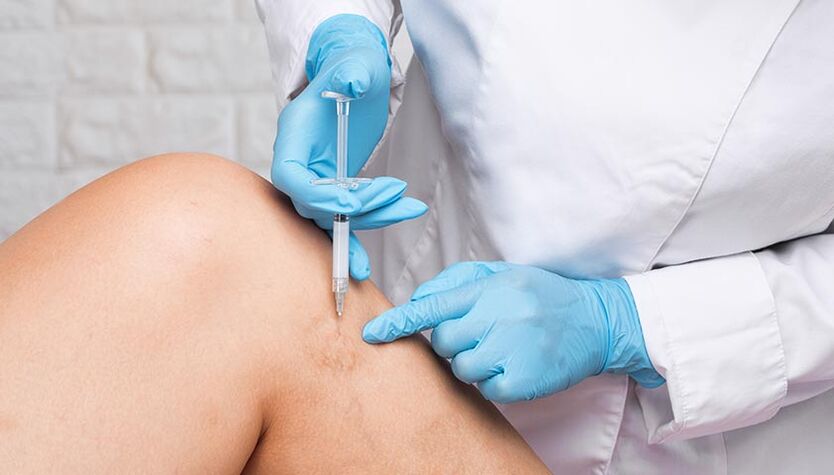
Endovenous laser thermoobliteration (EVLO). A catheter with laser light guidance is inserted into the vessel through a small incision. The thermal energy of the laser heats the vein, and it becomes obliterated— "closed. "After a few months, the vessel is replaced by connective tissue and disappears. This procedure is performed on an outpatient basis.
Radiofrequency vein obliteration (RFO) is the effect of high frequency current on the inner surface of blood vessels. Through micropuncture, a catheter is inserted into a vein, which is connected to a device that produces radio frequency pulses. Inside the vessel, radio waves are converted into heat energy, which "seals" the veins.
With EVLO, the vein is briefly exposed to high temperatures; with RFO, the temperature is lower, but the session is longer. Both procedures are effective and safe.
NTNT elimination, or non-thermal non-tumescent method:
- removal of veins using cyanoacrylate glue;
- mechanochemical elimination, where mechanical and chemical effects on the vessel occur simultaneously.
Destruction of NTNT is the most modern, low-traumatic method to treat varicose veins with a short recovery period.
Phlebectomy is the removal of the saphenous vein that has developed varicose veins. It can be performed as an independent operation or combined with other techniques. Varicose veins are removed under local anesthesia through a small puncture.
Prevention of varicose veins
You can prevent the development of varicose veins if you follow simple preventive rules in everyday life.
A combination of provoking factors—sitting for long periods of time with legs crossed, wearing uncomfortable shoes—increases the risk of varicose veins in the legs.
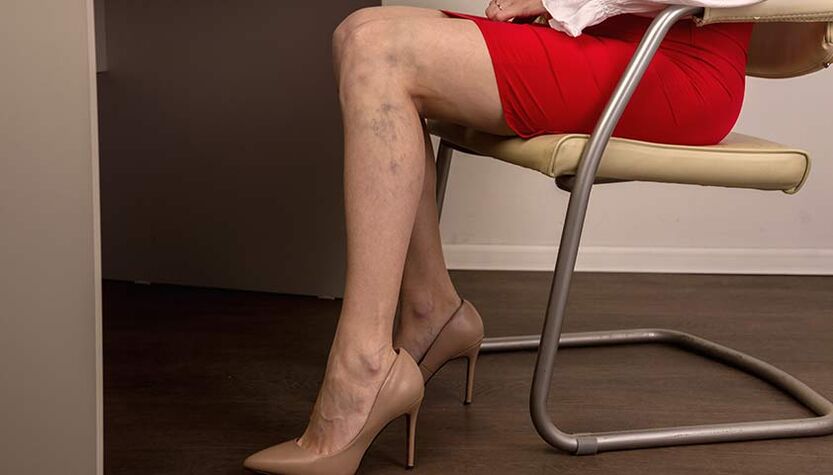
Prevention of varicose veins - what you need to know:
- moderate physical activity (walking, swimming, leg exercises) and resting with elevated legs increase the free movement of blood through the vessels and help prevent stagnation in the veins;
- rational nutrition and normalization of body weight lead to strengthening of blood vessels;
- wearing loose clothing that does not restrict movement helps improve blood circulation;
- cold shower in summer helps maintain vein tone;
- comfortable shoes with a low heel (no more than 3 cm) make it possible to avoid improper loads on the legs and blood flow disorders;
- A reasonable approach to visiting saunas and steam baths allows you to maintain normal blood flow (long-term heat procedures greatly expand the veins, so blood flow slows down).























